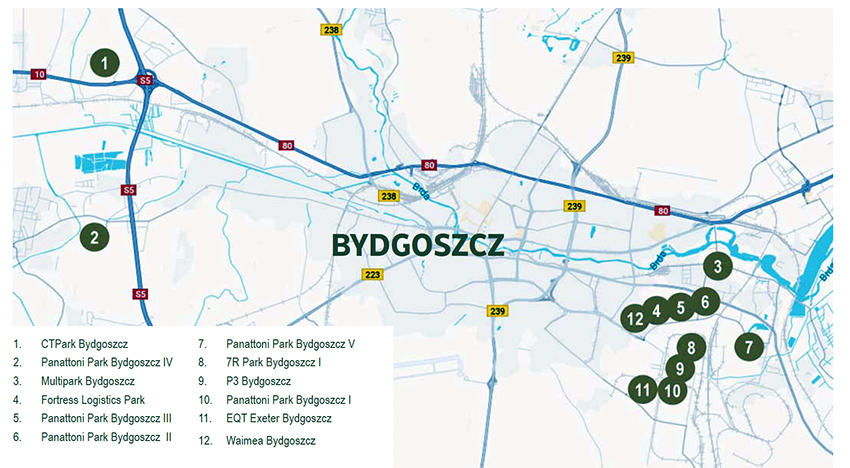Bydgoszcz: Expanding industrial and logistics market drives regional growth
Bydgoszcz is reinforcing its status as a key industrial and logistics hub in north-central Poland, building on a long-standing economic tradition and evolving infrastructure. According to a recent report by Immo Consulting, Local Landscape – Report on the Warehouse and Industrial Market in Bydgoszcz 2025, the city and the wider Kuyavian-Pomeranian region have seen warehouse capacity increase more than fivefold over the past decade. High occupancy levels, coupled with consistent demand, are encouraging developers to launch new projects and expand existing facilities.
Historically, Bydgoszcz’s position at the intersection of major trade routes shaped its early economic development, fostering a strong culture of trade and craftsmanship. This foundation paved the way for the city’s industrial expansion after Poland regained independence, with factories in chemicals and electrical engineering playing a major role. The post-war period continued this trajectory, with companies like Eltra, Jutrzenka, Zachem, Kobra, and Romet emerging as leading employers.
Since the political and economic transition of 1989, Bydgoszcz has diversified, investing in technology, education, and tourism infrastructure to align with market economy demands. Today, major companies such as PESA, Unilever, and Atos exemplify this blend of industrial heritage and innovation.
The city’s robust transport infrastructure supports its industrial ambitions. Bydgoszcz benefits from proximity to key expressways like the S5 and S10, linking it to the A1 motorway and facilitating regional and national connections. Investments in urban infrastructure, including road improvements, upgraded lighting, and new cycling paths, continue to enhance accessibility for residents and businesses.
Rail and water transport further strengthen the city’s logistics network. Bydgoszcz hosts one of Poland’s largest railway junctions, with recent modernisation projects boosting freight transport speeds and capacity. The E65 line between Bydgoszcz and Warsaw, now allowing trains to operate at 160 km/h, exemplifies these improvements. Additional works, including upgrades to routes connecting Gdynia, Poznań, and Toruń, are set to expand the city’s reach. Complementing this network, the river port operated by Żegluga Bydgoska connects Bydgoszcz to the MDW E70 waterway, linking Western and Eastern Europe. Bydgoszcz International Airport, located just 3 km from the city centre, provides air cargo handling, including services for hazardous goods.
Labour market indicators reflect Bydgoszcz’s economic vitality. In July 2024, the unemployment rate stood at 2.3%, below the national average. Employment is concentrated in industry, trade, construction, transport, and warehousing. Higher education institutions attract over 30,000 students annually, with strong demand for engineering and economics programmes.
Business development is bolstered by institutional support. The Pomeranian Special Economic Zone and Bydgoszcz Technology Park offer investment incentives, tax exemptions, and assistance with administrative processes, encouraging both domestic and foreign investment.
The city’s industrial base extends beyond traditional manufacturing. Bydgoszcz is a hub for the defence sector, home to firms like Military Aviation Works, Nitro Chem, Belma, and Teldat. The tool and polymer processing industries also play a significant role, supplying moulds and plastic products to sectors including automotive, food, medical, and packaging. The Bydgoszcz Industrial Cluster Tool Valley coordinates activities and supports businesses in these fields.
Emerging industries are adding new dimensions to Bydgoszcz’s economy. Companies such as Sybilla Technologies, Pegasus Aerospace, and Cilium Engineering are advancing projects in satellite systems, ground observation technologies, and aerospace engineering, positioning the city in the growing space economy.
The warehouse and industrial property market reflects these broader trends. In 2024, over 51,000 sqm of space was leased in Bydgoszcz, with a further 34,000 sqm leased in early 2025. Key deals included Nissin Logistics at Panattoni Park Bydgoszcz IV (42,000 sqm), LPP Logistics at Panattoni Park Bydgoszcz II (18,000 sqm), and Rohlig Suus at 7R Park Bydgoszcz (16,500 sqm). The vacancy rate in the city is 2.78%, prompting developers to respond with new projects totalling over 300,000 sqm.
Facilities such as P3 Bydgoszcz and Fortress Logistics Park Bydgoszcz illustrate the city’s focus on sustainability and adaptability. Developments are designed to accommodate diverse tenant needs, with build-to-suit options and sustainable features including rooftop photovoltaic systems, LED lighting with smart controls, and advanced building management systems to optimise energy use.
Rental rates have stabilised after recent increases, with base rents ranging from €3.30 to €4.20 per sqm per month and effective rents, after incentives, between €2.90 and €3.40. The market’s stability and availability of incentives are attracting tenants from sectors including logistics, food production, and manufacturing.
With its combination of industrial expertise, modern infrastructure, and supportive economic policies, Bydgoszcz continues to attract investors, developers, and tenants seeking opportunities in Poland’s growing industrial and logistics market. The city’s trajectory reflects both its historical foundations and its capacity to adapt to evolving economic demands.
Source and Image: Immo Consulting









